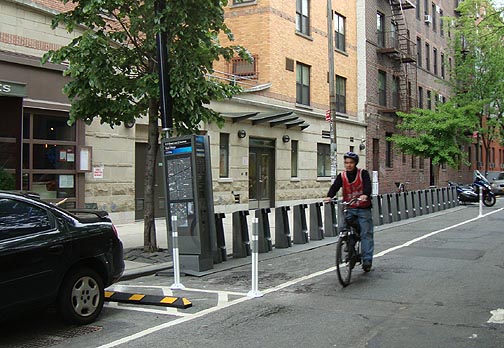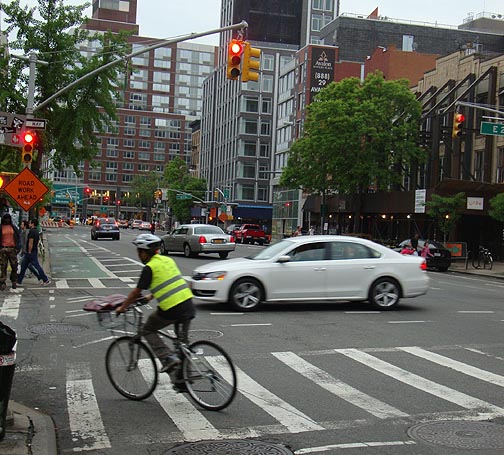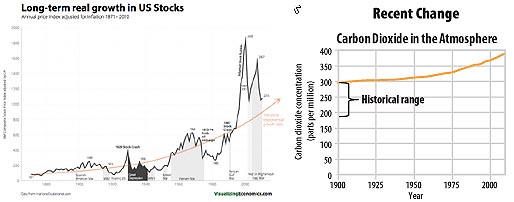Cycling is a great example of an EcoOptimistic solution, as I’ve written about before. It works on so many angles that it surpasses the win-win-win solutions that I often discuss here. It relieves congestion since replacing a car with a bicycle takes up much less space. It relieves pollution since it is essentially a zero-emission mode of transportation. (Not counting the incremental increase in food required to generate the human muscle power.) It takes a lot less energy and materials (some of them toxic, like PC and the nasties in batteries) to make a bicycle than a car. It improves health since, instead of sitting in a car, you’re powering the bicycle. And it’s good for us in another significant way by reducing both the number and severity of accidents; a bicycle and rider, at cycling speeds, constitute a lot less inertia than a one or two ton vehicle at driving speeds.
Which leads us to one of the two cycling topics filling my blog world this week. The first one is known as the Idaho Stop, a law that’s been in place in Idaho for 30 years and is now being considered elsewhere, that says a cyclist may proceed through a stop sign or red light after slowing or stopping to verify that there is no conflicting vehicular or pedestrian traffic. In essence, a cyclist can treat a red light as a stop sign, and a stop sign as a yield.
The discussions this week arose largely due to an Atlantic Cities post by Sarah Goodyear, whose writing I usually enjoy and agree with. This post, though, was titled “Cyclists Aren’t ‘Special,’ and They Shouldn’t Play by Their Own Rules.” The gist of her point, which I’ve heard from friends as well, is that cyclists should have to obey the law just as drivers do. Technically, legally, of course, that’s correct. But that’s close to where my agreement with Goodyear ends. While I wouldn’t say cyclists are special – that implies a category better than others – I think the relevant point is that cyclists are different, in the sense that a person on a 20 or 30 pound bicycle riding at single digit speeds is very different from a person in a one or two ton vehicle moving at double digit speeds. It’s basic physics: the much greater mass moving at higher speeds can cause magnitudes more damage. Plus cars and trucks are much larger and less maneuverable.
Which means that, yes, cyclists should have their own set of rules, and those rules should include the Idaho stop. It makes no sense at all for the same rules to apply to life-threatening and slower-to-stop vehicles as to puny bicycles. (I’m certainly not the first to make this argument. See here, here, here, here and here, among others.)
If this was recognized, and a more reasoned and applicable set of laws was created for bicycles, then the police could concentrate on true law breakers: the cyclists who ride unsafely and who endanger others; the ones who run red lights and stop signs without slowing and yielding; the ones who ride the wrong way. (I’m talkin’ to you, food delivery cyclists.)
Actually, I do sympathize somewhat with the delivery cyclists. When a delivery is four blocks away but the wrong direction, and because of one-way streets the alternative involves adding an extra three or more blocks, and you’re getting paid by the delivery, the temptation to take the shorter route is high. I’ll ride the wrong direction on occasion, too. I have a choice, when riding home, of going about 150 feet the wrong way on my low-speed lightly-traveled block, or going an extra five blocks, three of which are on much more trafficked and dangerous streets, and involve crossing a major street twice to get to and from the bike lane. I endanger no one in my brief sojourn in illegality and, in addition to adding a lot of time, endanger myself far more by taking the legal route. But, unlike the simple and clear Idaho stop, I’m not sure how to legitimize the good judgment I feel I exercise there.
I’d be willing, though, to trade off that example (and perhaps walk my bike that 150 feet) for the peace of mind of being to proceed slowly through a stop when all is clear without risk of getting a one or two hundred dollar ticket. In short, make the rules make sense and then apply them as rigorously as they are applied to drivers.
At the outset here, I said there are currently two cycling topics causing much bloggery. That second one is more New York City-specific and has hit both new media and traditional press, provoked by the rollout of the long-awaited CitiBike share system. (The racks have been appearing over the last couple of weeks. The bicycles come next and the system goes live on Memorial Day weekend.) Though the city held many public meetings to determine the locations of the bike racks, it now seems, to judge by the recent reports and letters, that people are surprised and aghast. Dig a little deeper and you’ll discover that it’s a small percentage that’s upset by the racks.
The reasons for objection range from esthetic (the currently empty racks, the Citibank logo on the bikes and signage), to loss of parking spaces, to safety (concerns that there will be more rude cyclists or that they may ride on sidewalks – which is and should be illegal for adults). Some residents of one historic district claim the bikes and racks don’t belong because they’re not what would have been in the original streets — as if parked cars or, for that matter, paved streets and parking signs are more historically correct. The arguments often take very different tones – as, it seems to me, is often true of liberal versus conservative vocalizations. Check out this particular exchange in the New York Daily News which began with a diplomatic approach by Paul Steely White of Transportation Alternatives (disclosure: I’ve been a member for 20 years) and evoked a strident response by the editorial board, attacking White as “the smug spokes-man.”

There’s one note on which a friend who has serious bike share issues and I agree: couldn’t they at least have designed the information kiosks so they could stand up straight?
Most of the objections, I think, come more simply from our resistance to change. There’s a physical aspect of change: the street or the park is going to look a bit different, and that takes getting used to for some. Equally important is resistance to challenging the primacy of cars. Why is it okay to provide (sometimes free) storage of private cars, taking up valuable public space, but not okay to provide storage spaces for public bicycles?
I suppose it’s easy for me, a car-free person (“carless” sounds like I’m deprived and missing something), to pose this question. But really, why should so much public land be given away to those who own cars, especially in a city like New York where most people don’t have cars? If car owners had to pay the real cost of the land they use for parking (here comes my economist side sneaking in again), you can bet there’d be a whole lot fewer cars and more bicycles, mass transit and car sharing. And a whole lot less congestion as well as a whole lot more open space for truly public use.
I’m sure there a few Citibike rack locations that need rethinking and perhaps relocating, which is precisely why the racks are designed to be easily moved. Let that public process happen. Indications are that the city Department of Transportation fully expects this to occur in some instances. But let’s keep that perhaps innate resistance to change in mind. Let’s allow some time to try it and see how things go. The experiences in London and elsewhere prove the validity of this approach. My prediction is that 99% of the locations will be just fine once we get used to this new and highly useful part of our streetscapes, and bike sharing will soon be seen as an integral part of cities’ transportation networks. We’ll all — cyclists and non-cyclists – enjoy less congested, less polluted and safer streets.







